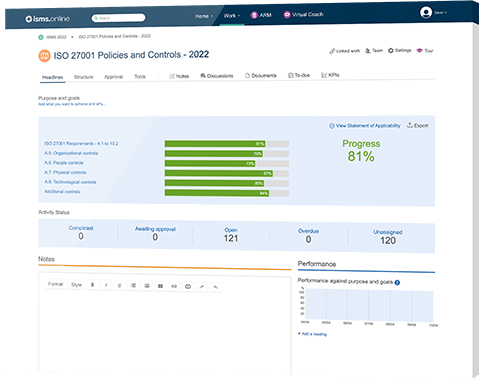
Being able to rely upon a pinpoint accurate synchronised time across an organisation’s information systems is of paramount importance not only for the ongoing operation of a company’s commercial systems, but also in the event of an ICT-related incident.
Accurate time representation gives an organisation the ability to provide itself and any law enforcement or regulatory bodies with a reliable account of how information has been managed, along with the actions of its employees and vendors.
Control 8.17 is a dual-purpose detective control that maintains risk by implementing controls which maintain accurate and reliable synchronisation of information system clocks, to assist in internal and external investigations, and incident monitoring.
| Control Type | Information Security Properties | Cybersecurity Concepts | Operational Capabilities | Security Domains |
|---|---|---|---|---|
| #Detective | #Integrity | #Protect #Detect | #Information Security Event Management | #Protection #Defence |
Control 8.17 primarily deals with technical matters, in the form of external data sources (atomic clocks etc.) linked to an organisation’s ICT systems.
As such, ownership should reside with the Head of IT (or organisational equivalent), with responsibility for the day-to-day integrity and efficiency of an organisation’s ICT infrastructure.
Control 8.17 avoids providing organisations with a step-by-step procedure for the management of system clocks, and instead offers broad guidance on how to make use of trusted reference points.
Control 8.17 asks organisations to establish a standard reference time that can be used across all commercial, logistical and maintenance-based systems as a trusted date and time source for all the organisation’s needs.
Organisations should:
Quite often, organisations make use of both on-premise and cloud-based systems side-by-side.
Cloud-hosted software and infrastructure platforms are usually managed by the vendor themselves, and will therefore utilise a separate time source to the organisation’s own infrastructure.
Time discrepancies in both managed and unmanaged hardware and systems should be taken into account at regular intervals, and any differences recorded to mitigate confusion in future investigations.
27002:2022-8.17 replaces 27002:2013-12.4.4 (Clock synchronisation).
27002:2022-8.17 replicates much of the same information contained within its 2013 counterpart, with one notable exception – 27002:2022-8.17 contains advice on how to manage time sources from the public and private cloud, and the implications for using systems on-premise that may be synchronised to a separate time source.
At ISMS.online, our cloud-based platform helps you to create, maintain and audit your ISO 27001 standards-based information security management system (ISMS). It provides you with customizable templates and tools that you can use to follow the requirements of ISO 27002.
Using this platform, you can establish your ISMS according to the international standard and use the provided checklists to ensure that your information security processes are in good shape.. You can also use ISMS.online for risk assessment and vulnerability assessment in order to identify weak points in your existing infrastructure which need immediate attention.
With all these tools and resources, ISMS.online can ultimately help you demonstrate compliance with ISO 27002.
Get in touch today to book a demo.

We’ll give you an 81% headstart
from the moment you log in
Book your demo
| ISO/IEC 27002:2022 Control Identifier | ISO/IEC 27002:2013 Control Identifier | Control Name |
|---|---|---|
| 5.7 | New | Threat intelligence |
| 5.23 | New | Information security for use of cloud services |
| 5.30 | New | ICT readiness for business continuity |
| 7.4 | New | Physical security monitoring |
| 8.9 | New | Configuration management |
| 8.10 | New | Information deletion |
| 8.11 | New | Data masking |
| 8.12 | New | Data leakage prevention |
| 8.16 | New | Monitoring activities |
| 8.23 | New | Web filtering |
| 8.28 | New | Secure coding |
| ISO/IEC 27002:2022 Control Identifier | ISO/IEC 27002:2013 Control Identifier | Control Name |
|---|---|---|
| 6.1 | 07.1.1 | Screening |
| 6.2 | 07.1.2 | Terms and conditions of employment |
| 6.3 | 07.2.2 | Information security awareness, education and training |
| 6.4 | 07.2.3 | Disciplinary process |
| 6.5 | 07.3.1 | Responsibilities after termination or change of employment |
| 6.6 | 13.2.4 | Confidentiality or non-disclosure agreements |
| 6.7 | 06.2.2 | Remote working |
| 6.8 | 16.1.2, 16.1.3 | Information security event reporting |
| ISO/IEC 27002:2022 Control Identifier | ISO/IEC 27002:2013 Control Identifier | Control Name |
|---|---|---|
| 7.1 | 11.1.1 | Physical security perimeters |
| 7.2 | 11.1.2, 11.1.6 | Physical entry |
| 7.3 | 11.1.3 | Securing offices, rooms and facilities |
| 7.4 | New | Physical security monitoring |
| 7.5 | 11.1.4 | Protecting against physical and environmental threats |
| 7.6 | 11.1.5 | Working in secure areas |
| 7.7 | 11.2.9 | Clear desk and clear screen |
| 7.8 | 11.2.1 | Equipment siting and protection |
| 7.9 | 11.2.6 | Security of assets off-premises |
| 7.10 | 08.3.1, 08.3.2, 08.3.3, 11.2.5 | Storage media |
| 7.11 | 11.2.2 | Supporting utilities |
| 7.12 | 11.2.3 | Cabling security |
| 7.13 | 11.2.4 | Equipment maintenance |
| 7.14 | 11.2.7 | Secure disposal or re-use of equipment |